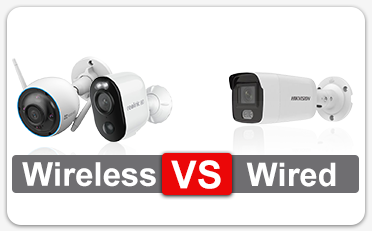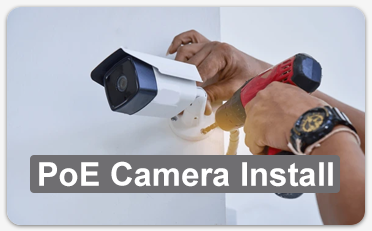Security Camera Terminology
Understanding Security Camera Terminology: A Beginner's Guide
Security cameras come in various specifications, including resolution, lens size, and form factor, each serving different purposes and offering unique features. Whether you're new to the world of surveillance or looking to upgrade your current setup, understanding the terminology is crucial. In this guide, we'll break down the key terms you need to know when shopping for security cameras.
Resolution:
Resolution refers to the clarity and sharpness of the image captured by a camera. It's measured in megapixels (MP). Here's what different resolutions mean:
| Resolution | Recommended Viewing Distance | Description |
|---|---|---|
| 2MP | Up to 30ft | Standard HD resolution suitable for most surveillance needs. Cameras with 2MP or less are becoming less and less common. |
| 4MP | Up to 50ft | Higher detail for areas needing more clarity, like parking lots or warehouses. |
| 5MP | Up to 70ft | Sharper images for high-security areas. |
| 8MP (4K) | Up to 100ft | Ultra-clear images for critical applications like facial recognition or license plate identification. |
-
2MP (1080p): This is the standard resolution for most HD security cameras. It provides clear and detailed images suitable for most surveillance needs.
-
4MP: Quickly becoming the new standard for security camera resolution, cameras with 4MP resolution offer higher clarity and detail compared to 2MP cameras. Most IP cameras that Security Camera Shop offers start at 4MP resolution.
-
5MP: With 5MP resolution, you get even sharper images and greater detail. These cameras are suitable for high-security areas where fine details are essential.
-
8MP (4K): Cameras with 8MP resolution, also known as 4K cameras, offer the highest level of detail and clarity. They are perfect for applications where capturing fine details is critical, such as facial recognition or license plate identification.
Focal Length:
The focal length determines the field of view and the distance at which objects appear clear and focused. Here are some common focal lengths and their applications:
-
2.8mm: Cameras with a 2.8mm lens provide a wide-angle view, suitable for monitoring large areas such as parking lots, yards, or building perimeters. This is typically the most common focal length.
-
4mm: A 4mm lens offers a moderate field of view, making it ideal for monitoring medium-sized areas such as hallways, entrances, or driveways.
-
6mm: Cameras with a 6mm lens provide a narrower field of view, allowing for more detailed surveillance of specific areas such as doorways, cash registers, or license plates. This focal length is becoming less and less common, as varifocal cameras offer more flexibility if your surviellance needs change.
- Varifocal Lens: Otherwise known as optical zoom, comes in many different combinations, but essentially enables to you have the flexibility of viewing a more wide (zoomed out) area, or a more focused/narrow (zoomed in) area. Some common varifocal focal lengths are 2.8-12mm (4X), 2.7-13.5mm (5X), 4.8-120mm (25X), 5.9-188.8mm (32X).
Form Factors:
Security cameras are available in various form factors, each designed for specific applications. Here are some common form factors:
-
Bullet Cameras: Bullet cameras are cylindrical in shape and often mounted on walls or ceilings. They are weatherproof and suitable for outdoor surveillance. Bullet cameras are highly visible, which can act as a deterrent to potential intruders.
-
Dome Cameras: Dome cameras are dome-shaped and are often used indoors. They are less conspicuous compared to bullet cameras and offer a wider range of motion. Dome cameras are also vandal-resistant, making them suitable for areas where tampering may occur.
-
Turret Cameras: Turret cameras, also known as eyeball cameras, are similar to dome cameras but without the dome cover. They offer a sleeker design and are less prone to glare or reflection, making them ideal for areas with challenging lighting conditions.
-
Pan & Tilt/PTZ Cameras: Pan & Tilt cameras offer the ability to pan (move horizontally) and tilt (move vertically) to provide a wider coverage area. They can be manually controlled or programmed to automatically track motion. PTZ cameras are commonly used in large outdoor spaces or areas that require constant monitoring.
Types of Cameras:
-
Analog Cameras:
- Pros: Cost-effective and compatibility with existing infrastructure. Usually requires one cable for power, and a separate cable for video transmission.
- Cons: Lower resolution, limited features, and scalability.
-
PoE (Power over Ethernet) Cameras:
- Pros: High resolution, advanced features, single cable solution, and scalability.
- Cons: Higher cost, network dependency, and potentially a bit more complex installation (when configuring IPs on more advanced systems).
Night Vision:
- IR Night Vision: Infrared (IR) night vision allows cameras to capture clear images in low-light conditions or complete darkness using infrared LEDs. It provides black and white footage. IR distance varies from camera to camera, but the most common max distance is 10-30m. IR night vision does not work well for viewing reflective surfaces (license plates) or determining the color of a suspects clothes or vehicle.
- Color Night Vision: Some cameras offer color night vision, which captures full-color images in low-light conditions, thanks to the help of a supplemental spotlight.
- Full Color Night Vision: This feature provides full-color images even in total darkness, using a wider aperture and large sensor, along with advanced image processing.
Audio:
- Built-in Mic: Cameras with a built-in microphone can capture audio along with video, providing an additional layer of surveillance.
- Two-Way Audio: Cameras with two-way audio capability allow for communication between the viewer and the camera's location. This feature is useful for interactive monitoring or deterring intruders. This feature is commonly found in doorbell cameras.
- Siren: Some cameras that features two-way audio also feature a siren, which can be used as an active deterrent for trespassers and intruders.
IP Ratings:
IP stands for Ingress Protection and the below rating suggest what level of dust or liquid the cameras can withstand.
| IP Rating | Solid Object Protection | Liquid Protection | Description |
|---|---|---|---|
| IP64 | 6 (Dust Tight) | 4 (Splashing) | Offers protection against dust ingress and splashing water, suitable for indoor use. |
| IP65 | 6 (Dust Tight) | 5 (Water Jets) | Provides protection against dust ingress and water jets, ideal for outdoor installations. |
| IP66 | 6 (Dust Tight) | 6 (Powerful Jets) | Resistant to dust and powerful water jets, suitable for harsh outdoor environments. Cameras with this rating and above are the most common, as they can resist heavy rain or snow. |
| IP67 | 6 (Dust Tight) | 7 (Immersion) | Offers complete protection against dust ingress and immersion in water up to 1 meter. IP67+ cameras are great for locations near water such as car washes, boardwalks and ports. |
| IP68 | 6 (Dust Tight) | 8 (Submersion) | Provides dust-tight protection and can withstand continuous submersion in water. |
IK10 Rating:
- IK10 Rating: The IK (Impact Protection) rating measures the degree of protection provided by an enclosure against external impacts. IK10 is the highest rating on the IK scale and is otherwise called vandal-proof, as it indicates the highest level of protection against impacts. Cameras with an IK10 (or IK09) are vandal-proof, and are suited for areas where cameras are susceptible to damage.
Understanding these key terms will help you make informed decisions when choosing security cameras for your home or business. Whether you prioritize resolution, lens size, or camera form factor, there's a perfect solution to meet your surveillance needs.
If you have any further questions or need assistance selecting the right security cameras, feel free to reach out to our cctv system experts. We're here to help you create a safer environment with the latest in surveillance technology.



